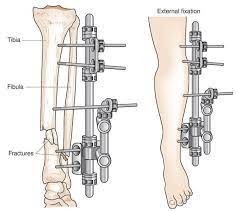A patient with a right lower leg fracture will be discharged home with an external fixation device in place. Which information will the nurse teach?
"Assess the skin under the foam boot twice daily"
"Take prophylactic antibiotics before any dental work for the rest of your life”
"Check and clean the pin insertion sites daily."
"Remove the external fixator for your shower
The Correct Answer is C
Pin site care is essential to prevent infections and other complications associated with external fixation devices. The nurse should instruct the patient to clean the pin insertion sites daily with a sterile saline solution or as per healthcare provider's instructions. The patient should also observe for signs of infection, such as redness, swelling, warmth, and drainage, and report any concerns to the healthcare provider.
Assessing the skin under the foam boot twice daily is not specific to external fixation devices, and it may not be relevant to this patient's care plan. The nurse should focus on teaching the patient about external fixation device care specifically.
Taking prophylactic antibiotics before any dental work for the rest of your life is not relevant to external fixation devices or right lower leg fractures. It is a recommendation for patients with certain heart conditions who may be at risk of developing infective endocarditis during dental procedures.
Removing the external fixator for the shower is not recommended as the device should be kept dry to prevent infections. The nurse should instruct the patient to cover the device with a waterproof dressing or plastic bag during showering to protect it from getting wet.

Nursing Test Bank
Naxlex Comprehensive Predictor Exams
Related Questions
Correct Answer is C
Explanation
Nitroprusside is a potent vasodilator medication used to rapidly reduce blood pressure in hypertensive emergencies. Its primary action is to dilate blood vessels, leading to a decrease in systemic vascular resistance and subsequent reduction in blood pressure.
Monitoring the client's blood pressure is crucial during the administration of nitroprusside to ensure that the medication is achieving the desired effect and that blood pressure is being appropriately controlled. The nurse will assess blood pressure frequently to adjust the infusion rate and titrate the medication to achieve the desired therapeutic effect while avoiding hypotension or other adverse effects.
Correct Answer is D
Explanation
Nausea and vomiting can lead to excessive loss of fluids and electrolytes, including potassium, from the body. Gastroenteritis is an inflammation of the gastrointestinal tract typically caused by viral or bacterial infections. It is commonly characterized by symptoms such as diarrhea, vomiting, abdominal pain, and fever. Antibiotics are not typically used to treat viral gastroenteritis and would not directly cause the electrolyte imbalance. Administration of IV Furosemide, a diuretic, would increase urine output but is not typically used to treat gastroenteritis. The fever itself may contribute to fluid loss but would not directly cause the electrolyte imbalance.
Whether you are a student looking to ace your exams or a practicing nurse seeking to enhance your expertise , our nursing education contents will empower you with the confidence and competence to make a difference in the lives of patients and become a respected leader in the healthcare field.
Visit Naxlex, invest in your future and unlock endless possibilities with our unparalleled nursing education contents today
Report Wrong Answer on the Current Question
Do you disagree with the answer? If yes, what is your expected answer? Explain.
Kindly be descriptive with the issue you are facing.
